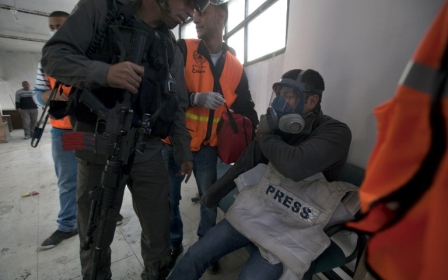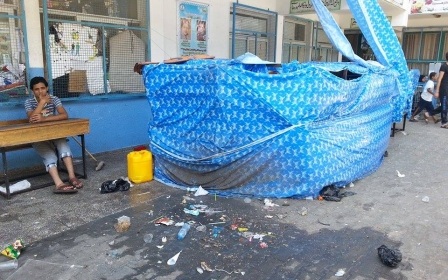When the night falls on displaced Gazans
GAZA CITY - Eight-year-old Mariam Alejla was sitting outside the entrance to Gaza’s biggest hospital, Shifa. Her leg was bandaged and she had a drip tube in her arm - but that's not why she was there.
The moment she saw this correspondent, she insisted on pulling me to an area behind the surgical department. “Come and see my mum and siblings… our home has been bombed,” she said.
Her mum, Umm Nidal Alejla, 47, was lying on a mattress she recovered from a damaged home just behind the surgical building. She was tending to a kettle heated by a small fire.
The family home - for all 20 of them - was a makeshift tent with random pieces of cloth; a Shifa-Hospital printed bed sheet, and pieces of nylon.
“We ran to UN school shelters, but were told, ‘You should have come earlier’” she said.
But it wasn’t a question of leaving earlier - the day the Alejla family decided to leave their home was dictated by the timing of Israeli bombs. She says she did her best to stay indoors until it simply became too dangerous to stay.
After two of her children were injured two weeks ago, she fled her home under Israeli bombardment. Since then she has been able to find anywhere to stay but Shifa hospital, among thousands of other Gazans.
Shifa Hospital external clinic has also been attacked, but Alejla and hundreds more would rather be here than in an overcrowded school classroom – they are well aware what happened in Jabaliya.
“We only ask mercy from Allah” she says, as she prepares four mattresses for another night’s sleep. Mariam disconnects her IV to sleep closer to her mum - she says it’s the only place she feels safe.
“It is cold at night, and we have two blankets to share between us all”, Mariam says, as her older brother tucks himself into “bed”.
Ambulance sirens call out - Mariam says that initially the children were keen to see who or what was on board, but now they are all familiar with the sound, and terrible sights of what they bring to the hospital.
“We lost everything in the house, all the cupboard contents were completely destroyed” Umm Nidal says, as her daughter Nida’a rinses mud out of the other children’s clothes.
The mother wants at least a real tent that she could erect near the ruins of her home.
“We are like beggars here, I can’t cope with all the children as some get sick, like the children inside the hospital” she says, pointing to four children showing symptoms of some acute stomach pain and skin irritation.
Her daughter Nida’a Alejla, 24, summarizes the story of many. “Everyday I have pains in my stomach. The doctors told me it’s from the overcrowding, lack of hygiene and clean drinking water.”
Unlike those sheltered in UNRWA schools, which are aid distribution points, the refugees at Shifa Hospital have received no aid so far.
The children and their mum survive on donations from people passing by on their way to buy a little bread, cheese and thyme, which they use to make tea. “That’s our breakfast, lunch and dinner” she said.
“I just ask Allah for some peace, so we can eat bread and salt on the ruins of what remains of our home”, said Umm Nidal.
In another tent nearby, sits Mervat Shanan, 22. She gave birth to a daughter yesterday, who is yet to be named by the family.
The baby is one of 4,500 new babies in Gaza born during the same period that around 2,000 Palestinians were killed, according to the Interior Ministry in Gaza.
Before coming to this cloth hut, Shanan lived with her husband, three other children and his 10 siblings, including his parents in a simple home north of Gaza Strip, close to the American School, before an Israeli tank shell and Drone missile hit their home, causing massive damage.
“During the last war, in 2012, an Israeli missile killed my daughter inside her bedroom. She was one-week old”.
This time, together with her husband Atta Shanan, 22, Mervat made the decision to keep the children safe by leaving the frontline where Israeli missiles struck most areas. He had thought that the American school would be an ideal shelter, but he saw that it was also hit.
“When the ceasefire began, we ran back to check our home, but found everything burned” says Atta Shanan.
Afterwards, he returned to the school class, but found it occupied by another family - he did not want to make trouble, but dragged his family and ran to all other schools, but found no free space. Now, his only place is also Shifa Hospital.
Shanan is one of 450,000 Gazans who fled their homes with nowhere else to go, unlike other war zones where some borders are open, Gaza is locked in, under Israeli siege by land, sea and air and Egypt only opens Rafah border-sporadically- to those with foreign-national passports.
Now his sisters have nowhere to sleep - everyone is squashed into a room no bigger than the garbage skip outside the gates of Shifa Hospital.
Night begins, the temperature drops and the Shanan family sleep close together to keep warm, before the hot day comes again. In this place, the mum breastfeeds, the children sleep, the mother slices bread and cheese, and the father pokes his head through a torn bedsheet to smoke.
At times, he sits outside the tent just to get some cool air - for everyone sleep is difficult while the hospital stays noisy and busy.
“It’s tough because we can’t just walk in to the surgical unit, to fill a bottle of water” he says, while carrying his 2 day-old baby.
His three daughters haven’t showered for over 20 days - “we tried to use facilities inside the hospital but we know that the patients with severe injuries are priority” he says as he hands over his small baby to his wife, and start to tuck his daughters in together under a thin blanket that separates them from the hard floor.
“We sleep side by side to protect each other. This is another dark period which will pass” he adds.
Middle East Eye propose une couverture et une analyse indépendantes et incomparables du Moyen-Orient, de l’Afrique du Nord et d’autres régions du monde. Pour en savoir plus sur la reprise de ce contenu et les frais qui s’appliquent, veuillez remplir ce formulaire [en anglais]. Pour en savoir plus sur MEE, cliquez ici [en anglais].




